Impact of Millennials on the Wine Industry: Research Analysis
VerifiedAdded on 2022/11/23
|27
|6032
|411
Report
AI Summary
This report investigates the impact of Millennials on the wine industry, focusing on consumer behavior and market trends. The introduction defines the research question and highlights the research gap, emphasizing the influence of Millennials on wine manufacturing. It discusses qualitative and quantitative data collection methods, including interviews, surveys, and statistical analysis techniques like MANOVA. The report provides examples of qualitative and quantitative data collection and analysis from existing research, such as consumer preference studies and wine selection behavior analysis. It then proposes a research design, outlining semi-structured interviews and surveys for data collection, and content analysis and statistical methods for data analysis. The conclusion summarizes the findings and the importance of understanding Millennial consumers for the wine industry's success. The report includes references and appendices to support the research.
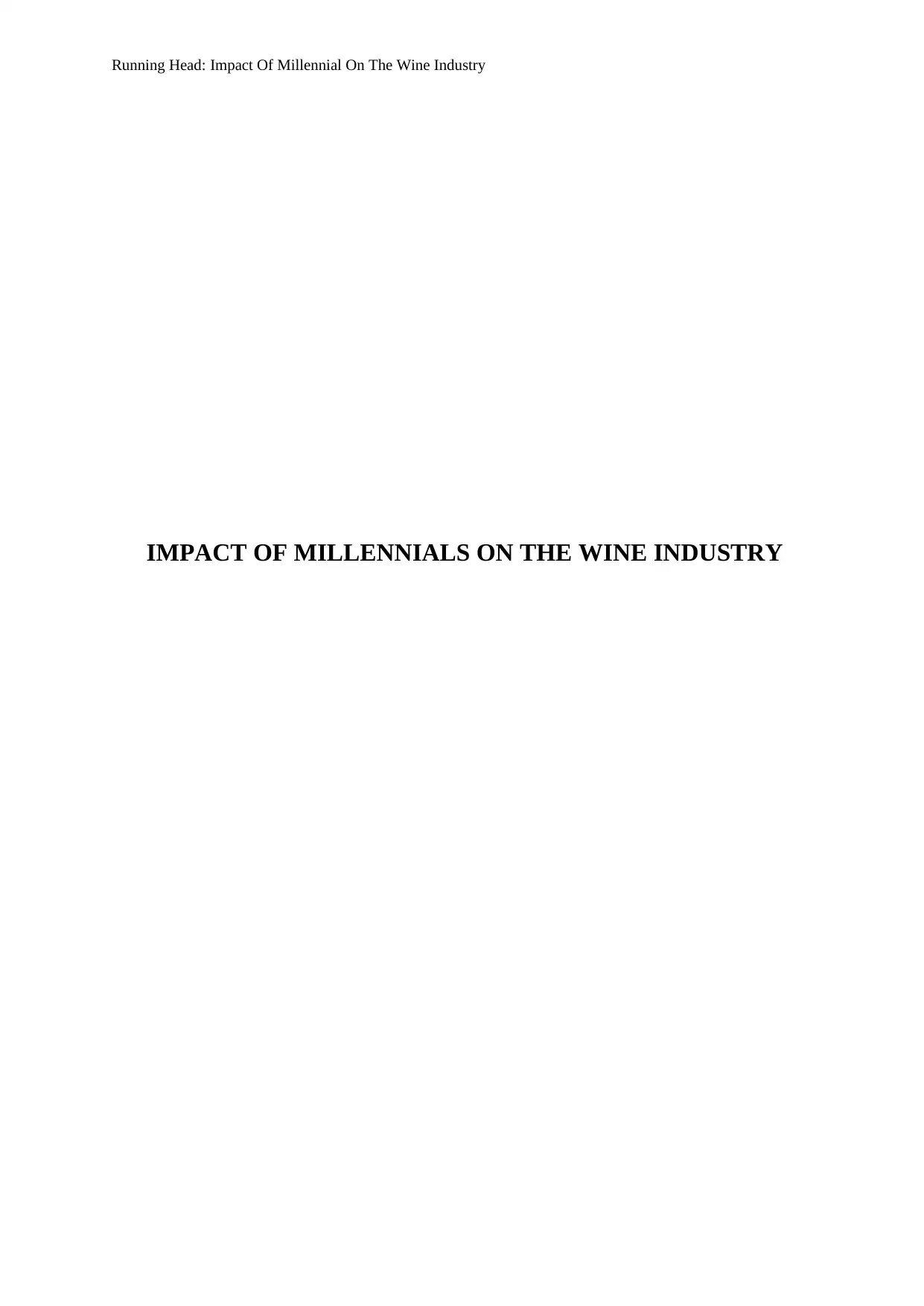
Running Head: Impact Of Millennial On The Wine Industry
IMPACT OF MILLENNIALS ON THE WINE INDUSTRY
IMPACT OF MILLENNIALS ON THE WINE INDUSTRY
Paraphrase This Document
Need a fresh take? Get an instant paraphrase of this document with our AI Paraphraser
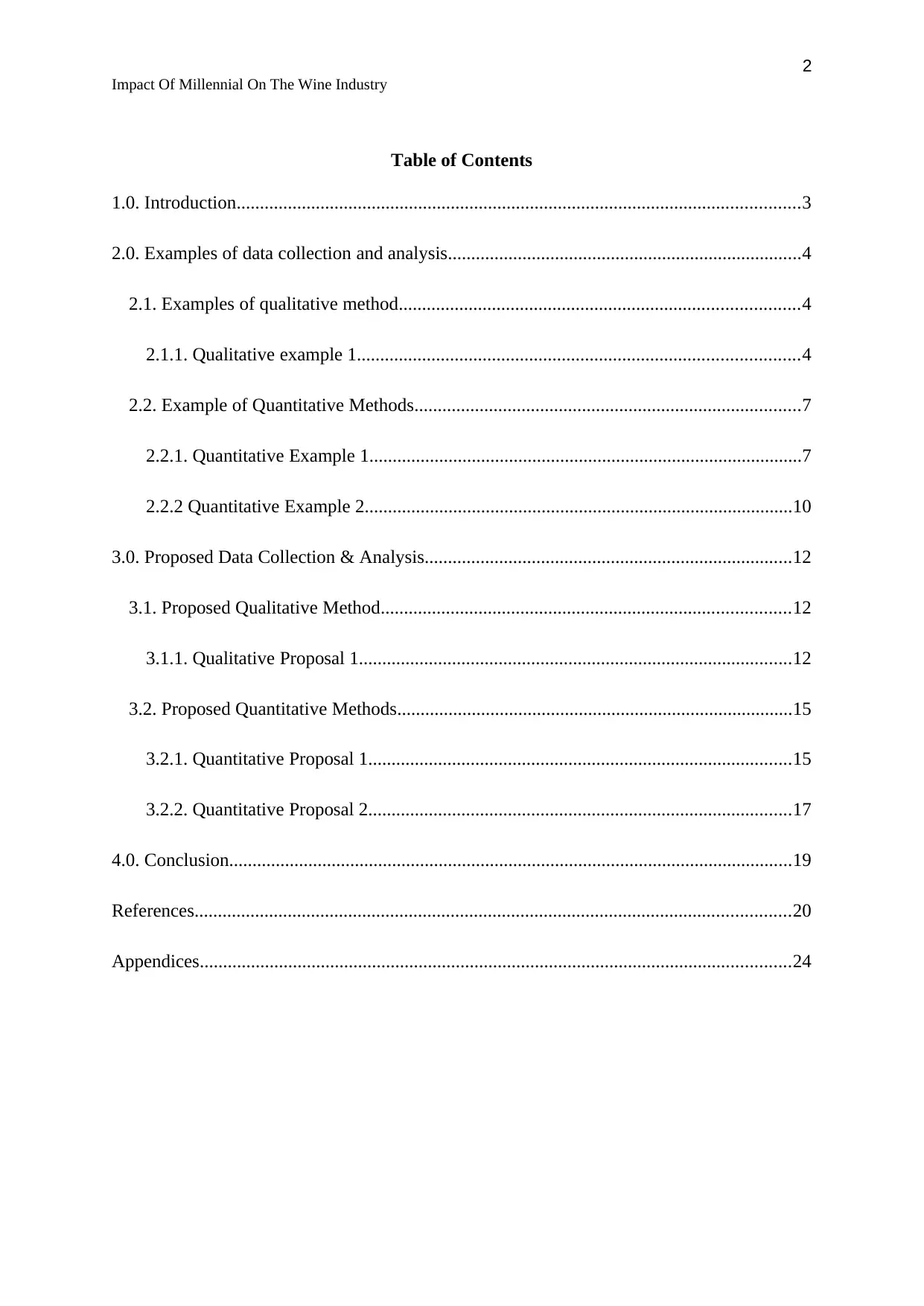
2
Impact Of Millennial On The Wine Industry
Table of Contents
1.0. Introduction.........................................................................................................................3
2.0. Examples of data collection and analysis............................................................................4
2.1. Examples of qualitative method......................................................................................4
2.1.1. Qualitative example 1...............................................................................................4
2.2. Example of Quantitative Methods...................................................................................7
2.2.1. Quantitative Example 1.............................................................................................7
2.2.2 Quantitative Example 2............................................................................................10
3.0. Proposed Data Collection & Analysis...............................................................................12
3.1. Proposed Qualitative Method........................................................................................12
3.1.1. Qualitative Proposal 1.............................................................................................12
3.2. Proposed Quantitative Methods.....................................................................................15
3.2.1. Quantitative Proposal 1...........................................................................................15
3.2.2. Quantitative Proposal 2...........................................................................................17
4.0. Conclusion.........................................................................................................................19
References................................................................................................................................20
Appendices...............................................................................................................................24
Impact Of Millennial On The Wine Industry
Table of Contents
1.0. Introduction.........................................................................................................................3
2.0. Examples of data collection and analysis............................................................................4
2.1. Examples of qualitative method......................................................................................4
2.1.1. Qualitative example 1...............................................................................................4
2.2. Example of Quantitative Methods...................................................................................7
2.2.1. Quantitative Example 1.............................................................................................7
2.2.2 Quantitative Example 2............................................................................................10
3.0. Proposed Data Collection & Analysis...............................................................................12
3.1. Proposed Qualitative Method........................................................................................12
3.1.1. Qualitative Proposal 1.............................................................................................12
3.2. Proposed Quantitative Methods.....................................................................................15
3.2.1. Quantitative Proposal 1...........................................................................................15
3.2.2. Quantitative Proposal 2...........................................................................................17
4.0. Conclusion.........................................................................................................................19
References................................................................................................................................20
Appendices...............................................................................................................................24
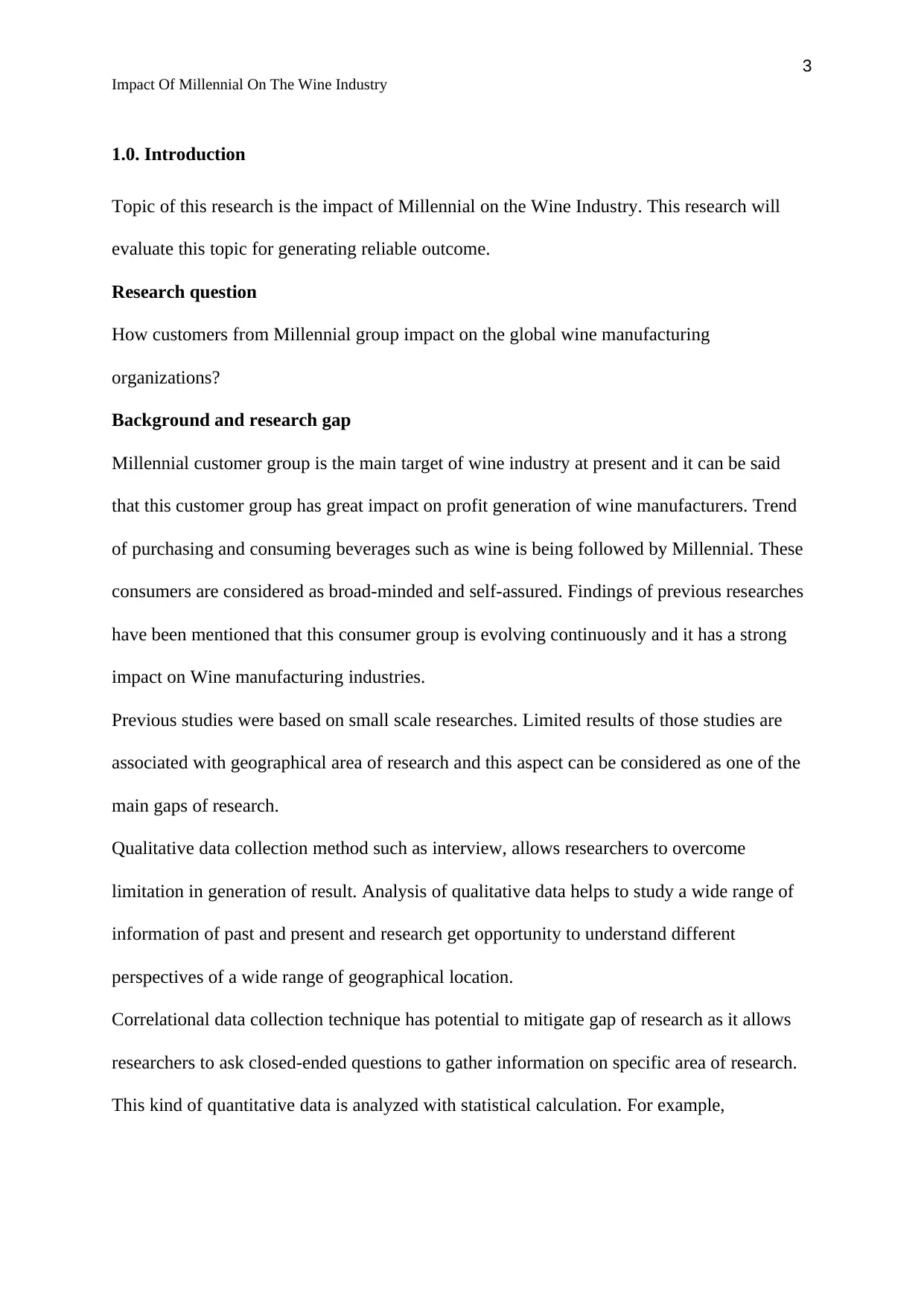
3
Impact Of Millennial On The Wine Industry
1.0. Introduction
Topic of this research is the impact of Millennial on the Wine Industry. This research will
evaluate this topic for generating reliable outcome.
Research question
How customers from Millennial group impact on the global wine manufacturing
organizations?
Background and research gap
Millennial customer group is the main target of wine industry at present and it can be said
that this customer group has great impact on profit generation of wine manufacturers. Trend
of purchasing and consuming beverages such as wine is being followed by Millennial. These
consumers are considered as broad-minded and self-assured. Findings of previous researches
have been mentioned that this consumer group is evolving continuously and it has a strong
impact on Wine manufacturing industries.
Previous studies were based on small scale researches. Limited results of those studies are
associated with geographical area of research and this aspect can be considered as one of the
main gaps of research.
Qualitative data collection method such as interview, allows researchers to overcome
limitation in generation of result. Analysis of qualitative data helps to study a wide range of
information of past and present and research get opportunity to understand different
perspectives of a wide range of geographical location.
Correlational data collection technique has potential to mitigate gap of research as it allows
researchers to ask closed-ended questions to gather information on specific area of research.
This kind of quantitative data is analyzed with statistical calculation. For example,
Impact Of Millennial On The Wine Industry
1.0. Introduction
Topic of this research is the impact of Millennial on the Wine Industry. This research will
evaluate this topic for generating reliable outcome.
Research question
How customers from Millennial group impact on the global wine manufacturing
organizations?
Background and research gap
Millennial customer group is the main target of wine industry at present and it can be said
that this customer group has great impact on profit generation of wine manufacturers. Trend
of purchasing and consuming beverages such as wine is being followed by Millennial. These
consumers are considered as broad-minded and self-assured. Findings of previous researches
have been mentioned that this consumer group is evolving continuously and it has a strong
impact on Wine manufacturing industries.
Previous studies were based on small scale researches. Limited results of those studies are
associated with geographical area of research and this aspect can be considered as one of the
main gaps of research.
Qualitative data collection method such as interview, allows researchers to overcome
limitation in generation of result. Analysis of qualitative data helps to study a wide range of
information of past and present and research get opportunity to understand different
perspectives of a wide range of geographical location.
Correlational data collection technique has potential to mitigate gap of research as it allows
researchers to ask closed-ended questions to gather information on specific area of research.
This kind of quantitative data is analyzed with statistical calculation. For example,
⊘ This is a preview!⊘
Do you want full access?
Subscribe today to unlock all pages.

Trusted by 1+ million students worldwide
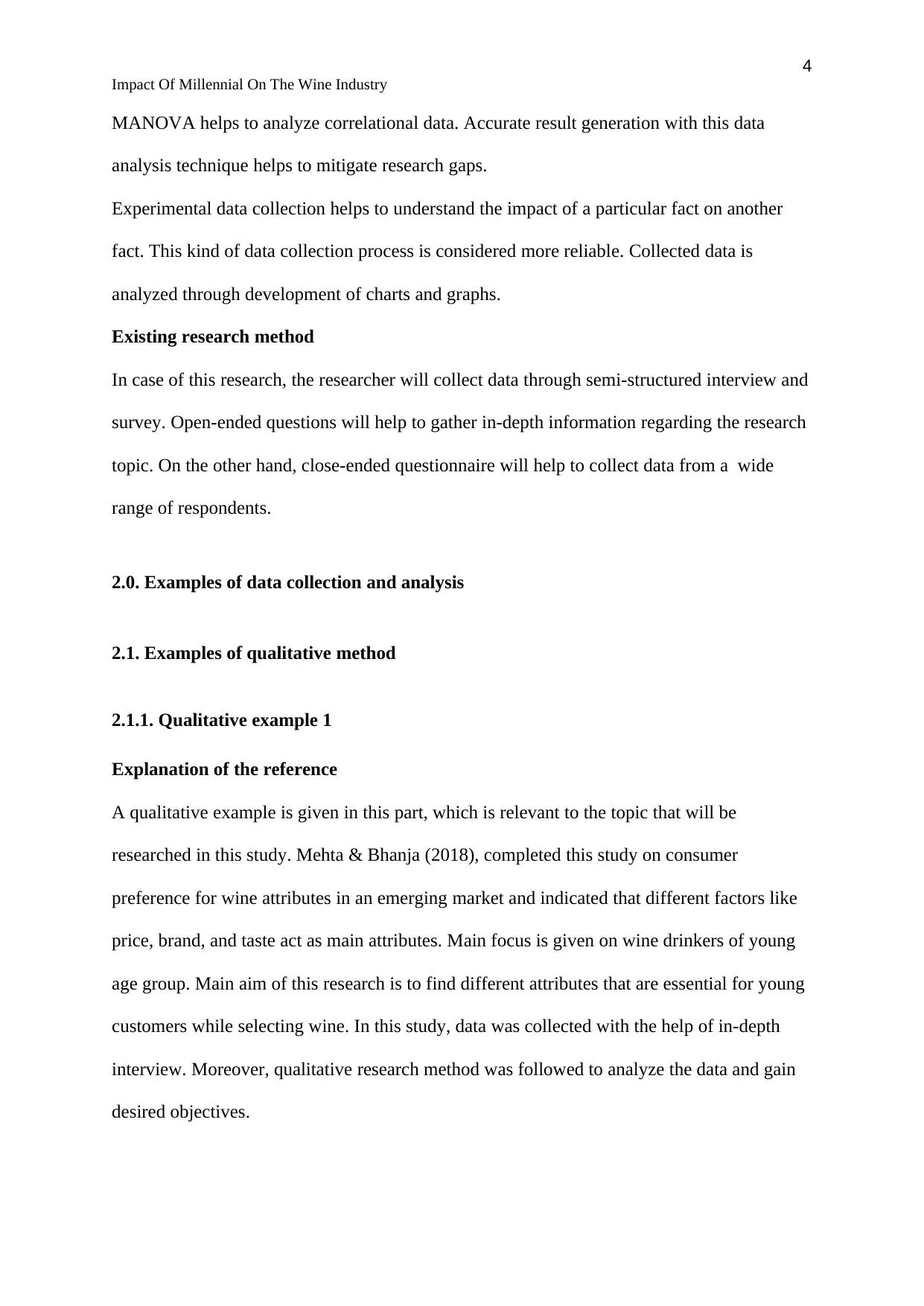
4
Impact Of Millennial On The Wine Industry
MANOVA helps to analyze correlational data. Accurate result generation with this data
analysis technique helps to mitigate research gaps.
Experimental data collection helps to understand the impact of a particular fact on another
fact. This kind of data collection process is considered more reliable. Collected data is
analyzed through development of charts and graphs.
Existing research method
In case of this research, the researcher will collect data through semi-structured interview and
survey. Open-ended questions will help to gather in-depth information regarding the research
topic. On the other hand, close-ended questionnaire will help to collect data from a wide
range of respondents.
2.0. Examples of data collection and analysis
2.1. Examples of qualitative method
2.1.1. Qualitative example 1
Explanation of the reference
A qualitative example is given in this part, which is relevant to the topic that will be
researched in this study. Mehta & Bhanja (2018), completed this study on consumer
preference for wine attributes in an emerging market and indicated that different factors like
price, brand, and taste act as main attributes. Main focus is given on wine drinkers of young
age group. Main aim of this research is to find different attributes that are essential for young
customers while selecting wine. In this study, data was collected with the help of in-depth
interview. Moreover, qualitative research method was followed to analyze the data and gain
desired objectives.
Impact Of Millennial On The Wine Industry
MANOVA helps to analyze correlational data. Accurate result generation with this data
analysis technique helps to mitigate research gaps.
Experimental data collection helps to understand the impact of a particular fact on another
fact. This kind of data collection process is considered more reliable. Collected data is
analyzed through development of charts and graphs.
Existing research method
In case of this research, the researcher will collect data through semi-structured interview and
survey. Open-ended questions will help to gather in-depth information regarding the research
topic. On the other hand, close-ended questionnaire will help to collect data from a wide
range of respondents.
2.0. Examples of data collection and analysis
2.1. Examples of qualitative method
2.1.1. Qualitative example 1
Explanation of the reference
A qualitative example is given in this part, which is relevant to the topic that will be
researched in this study. Mehta & Bhanja (2018), completed this study on consumer
preference for wine attributes in an emerging market and indicated that different factors like
price, brand, and taste act as main attributes. Main focus is given on wine drinkers of young
age group. Main aim of this research is to find different attributes that are essential for young
customers while selecting wine. In this study, data was collected with the help of in-depth
interview. Moreover, qualitative research method was followed to analyze the data and gain
desired objectives.
Paraphrase This Document
Need a fresh take? Get an instant paraphrase of this document with our AI Paraphraser
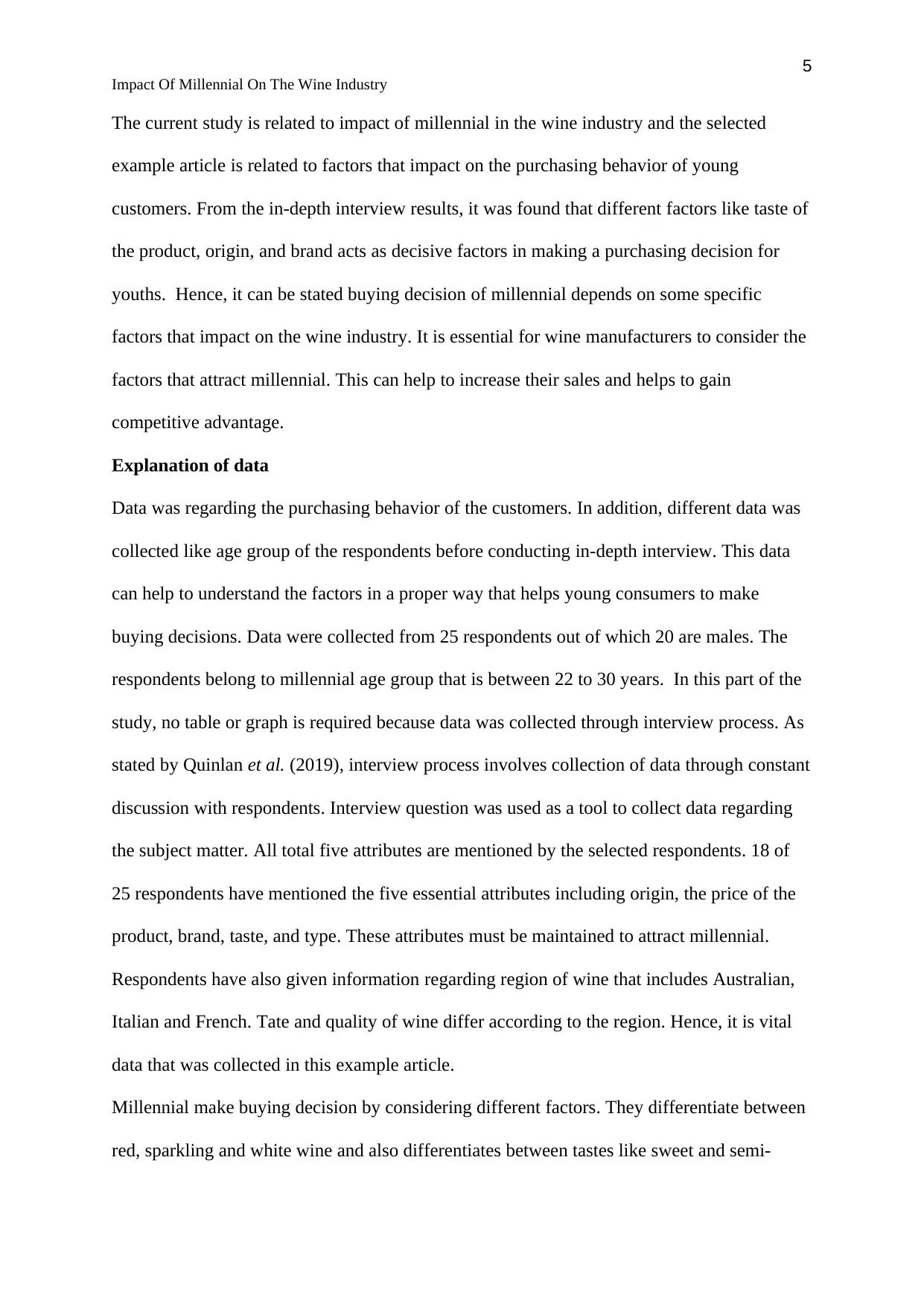
5
Impact Of Millennial On The Wine Industry
The current study is related to impact of millennial in the wine industry and the selected
example article is related to factors that impact on the purchasing behavior of young
customers. From the in-depth interview results, it was found that different factors like taste of
the product, origin, and brand acts as decisive factors in making a purchasing decision for
youths. Hence, it can be stated buying decision of millennial depends on some specific
factors that impact on the wine industry. It is essential for wine manufacturers to consider the
factors that attract millennial. This can help to increase their sales and helps to gain
competitive advantage.
Explanation of data
Data was regarding the purchasing behavior of the customers. In addition, different data was
collected like age group of the respondents before conducting in-depth interview. This data
can help to understand the factors in a proper way that helps young consumers to make
buying decisions. Data were collected from 25 respondents out of which 20 are males. The
respondents belong to millennial age group that is between 22 to 30 years. In this part of the
study, no table or graph is required because data was collected through interview process. As
stated by Quinlan et al. (2019), interview process involves collection of data through constant
discussion with respondents. Interview question was used as a tool to collect data regarding
the subject matter. All total five attributes are mentioned by the selected respondents. 18 of
25 respondents have mentioned the five essential attributes including origin, the price of the
product, brand, taste, and type. These attributes must be maintained to attract millennial.
Respondents have also given information regarding region of wine that includes Australian,
Italian and French. Tate and quality of wine differ according to the region. Hence, it is vital
data that was collected in this example article.
Millennial make buying decision by considering different factors. They differentiate between
red, sparkling and white wine and also differentiates between tastes like sweet and semi-
Impact Of Millennial On The Wine Industry
The current study is related to impact of millennial in the wine industry and the selected
example article is related to factors that impact on the purchasing behavior of young
customers. From the in-depth interview results, it was found that different factors like taste of
the product, origin, and brand acts as decisive factors in making a purchasing decision for
youths. Hence, it can be stated buying decision of millennial depends on some specific
factors that impact on the wine industry. It is essential for wine manufacturers to consider the
factors that attract millennial. This can help to increase their sales and helps to gain
competitive advantage.
Explanation of data
Data was regarding the purchasing behavior of the customers. In addition, different data was
collected like age group of the respondents before conducting in-depth interview. This data
can help to understand the factors in a proper way that helps young consumers to make
buying decisions. Data were collected from 25 respondents out of which 20 are males. The
respondents belong to millennial age group that is between 22 to 30 years. In this part of the
study, no table or graph is required because data was collected through interview process. As
stated by Quinlan et al. (2019), interview process involves collection of data through constant
discussion with respondents. Interview question was used as a tool to collect data regarding
the subject matter. All total five attributes are mentioned by the selected respondents. 18 of
25 respondents have mentioned the five essential attributes including origin, the price of the
product, brand, taste, and type. These attributes must be maintained to attract millennial.
Respondents have also given information regarding region of wine that includes Australian,
Italian and French. Tate and quality of wine differ according to the region. Hence, it is vital
data that was collected in this example article.
Millennial make buying decision by considering different factors. They differentiate between
red, sparkling and white wine and also differentiates between tastes like sweet and semi-
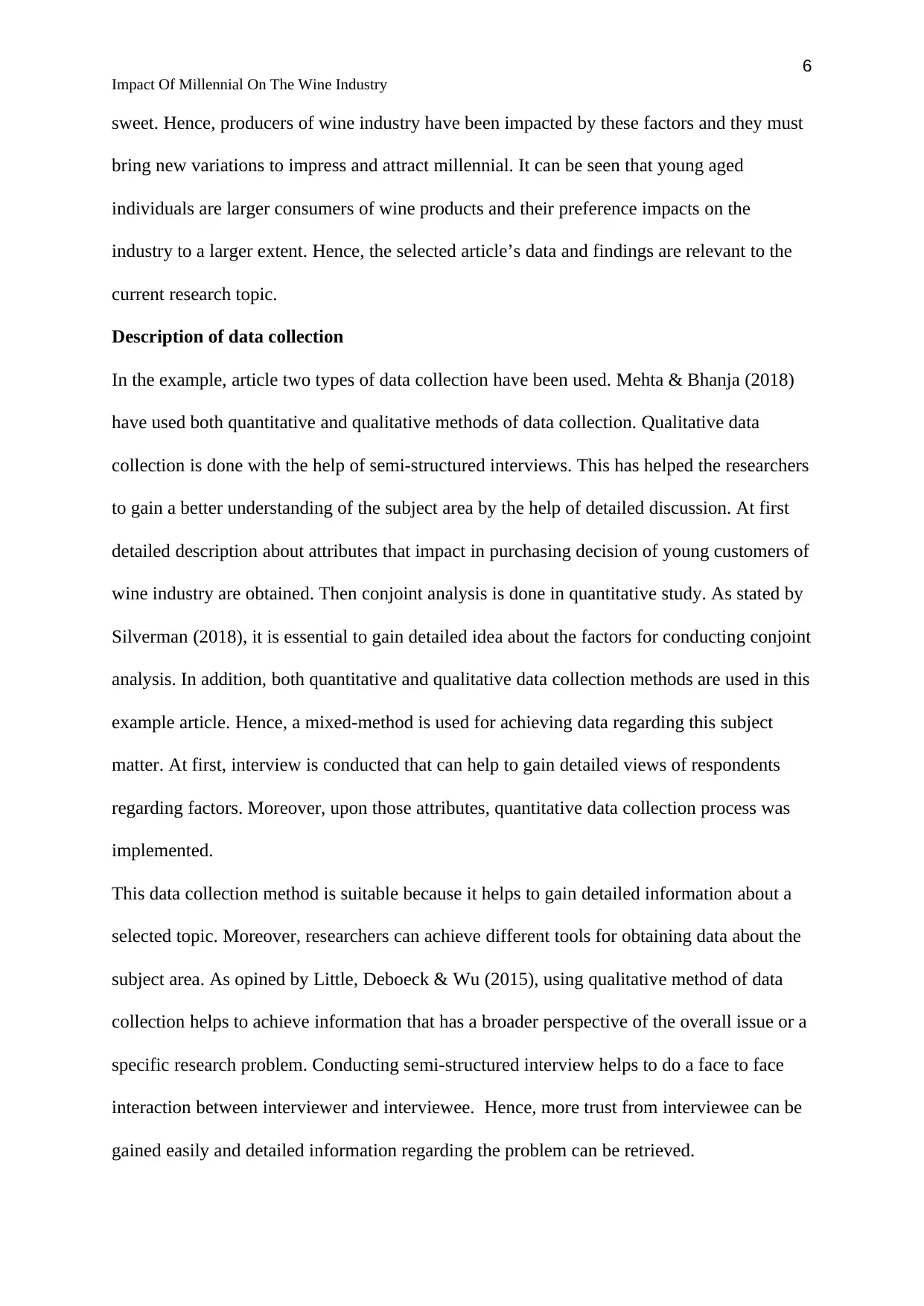
6
Impact Of Millennial On The Wine Industry
sweet. Hence, producers of wine industry have been impacted by these factors and they must
bring new variations to impress and attract millennial. It can be seen that young aged
individuals are larger consumers of wine products and their preference impacts on the
industry to a larger extent. Hence, the selected article’s data and findings are relevant to the
current research topic.
Description of data collection
In the example, article two types of data collection have been used. Mehta & Bhanja (2018)
have used both quantitative and qualitative methods of data collection. Qualitative data
collection is done with the help of semi-structured interviews. This has helped the researchers
to gain a better understanding of the subject area by the help of detailed discussion. At first
detailed description about attributes that impact in purchasing decision of young customers of
wine industry are obtained. Then conjoint analysis is done in quantitative study. As stated by
Silverman (2018), it is essential to gain detailed idea about the factors for conducting conjoint
analysis. In addition, both quantitative and qualitative data collection methods are used in this
example article. Hence, a mixed-method is used for achieving data regarding this subject
matter. At first, interview is conducted that can help to gain detailed views of respondents
regarding factors. Moreover, upon those attributes, quantitative data collection process was
implemented.
This data collection method is suitable because it helps to gain detailed information about a
selected topic. Moreover, researchers can achieve different tools for obtaining data about the
subject area. As opined by Little, Deboeck & Wu (2015), using qualitative method of data
collection helps to achieve information that has a broader perspective of the overall issue or a
specific research problem. Conducting semi-structured interview helps to do a face to face
interaction between interviewer and interviewee. Hence, more trust from interviewee can be
gained easily and detailed information regarding the problem can be retrieved.
Impact Of Millennial On The Wine Industry
sweet. Hence, producers of wine industry have been impacted by these factors and they must
bring new variations to impress and attract millennial. It can be seen that young aged
individuals are larger consumers of wine products and their preference impacts on the
industry to a larger extent. Hence, the selected article’s data and findings are relevant to the
current research topic.
Description of data collection
In the example, article two types of data collection have been used. Mehta & Bhanja (2018)
have used both quantitative and qualitative methods of data collection. Qualitative data
collection is done with the help of semi-structured interviews. This has helped the researchers
to gain a better understanding of the subject area by the help of detailed discussion. At first
detailed description about attributes that impact in purchasing decision of young customers of
wine industry are obtained. Then conjoint analysis is done in quantitative study. As stated by
Silverman (2018), it is essential to gain detailed idea about the factors for conducting conjoint
analysis. In addition, both quantitative and qualitative data collection methods are used in this
example article. Hence, a mixed-method is used for achieving data regarding this subject
matter. At first, interview is conducted that can help to gain detailed views of respondents
regarding factors. Moreover, upon those attributes, quantitative data collection process was
implemented.
This data collection method is suitable because it helps to gain detailed information about a
selected topic. Moreover, researchers can achieve different tools for obtaining data about the
subject area. As opined by Little, Deboeck & Wu (2015), using qualitative method of data
collection helps to achieve information that has a broader perspective of the overall issue or a
specific research problem. Conducting semi-structured interview helps to do a face to face
interaction between interviewer and interviewee. Hence, more trust from interviewee can be
gained easily and detailed information regarding the problem can be retrieved.
⊘ This is a preview!⊘
Do you want full access?
Subscribe today to unlock all pages.

Trusted by 1+ million students worldwide
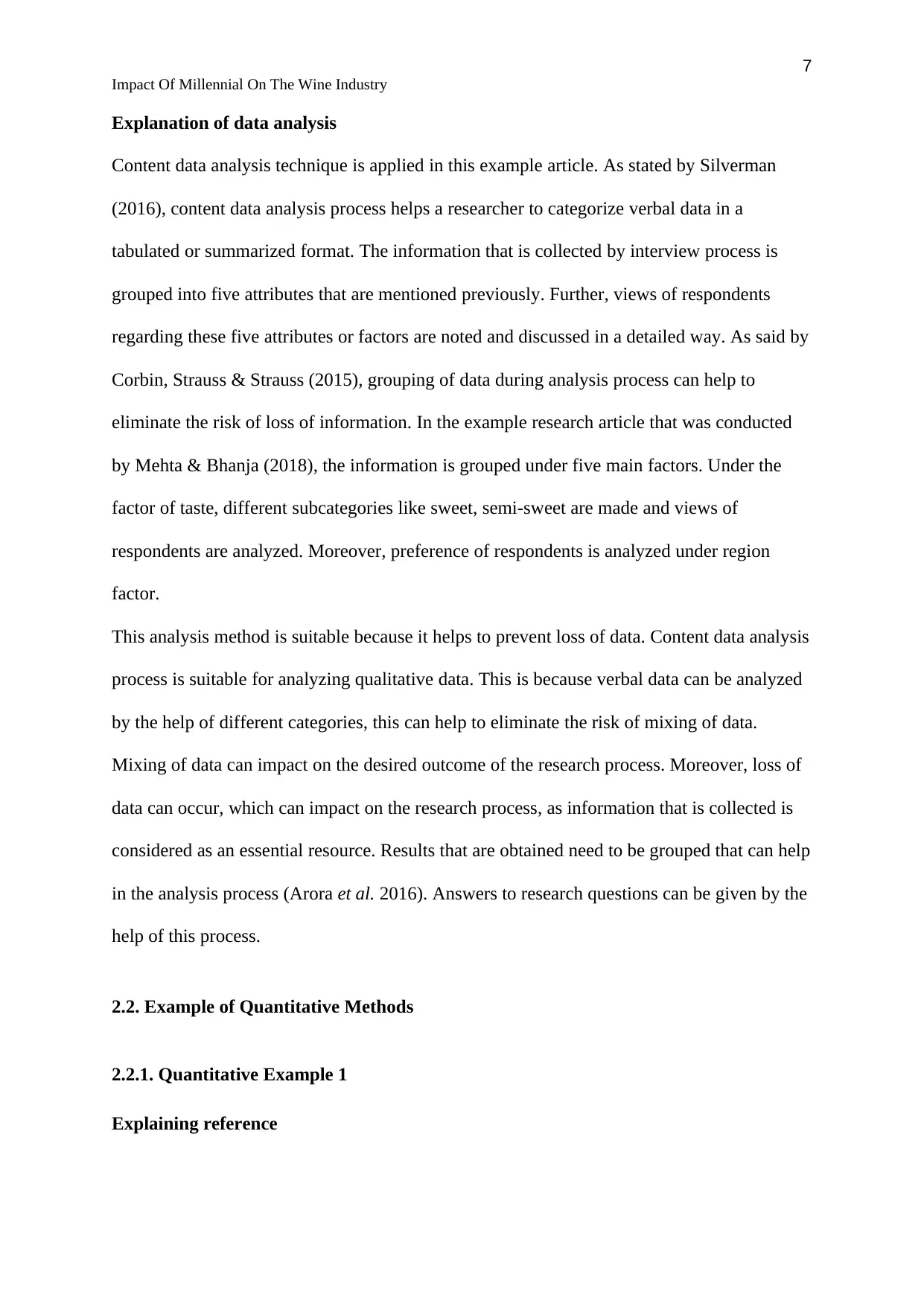
7
Impact Of Millennial On The Wine Industry
Explanation of data analysis
Content data analysis technique is applied in this example article. As stated by Silverman
(2016), content data analysis process helps a researcher to categorize verbal data in a
tabulated or summarized format. The information that is collected by interview process is
grouped into five attributes that are mentioned previously. Further, views of respondents
regarding these five attributes or factors are noted and discussed in a detailed way. As said by
Corbin, Strauss & Strauss (2015), grouping of data during analysis process can help to
eliminate the risk of loss of information. In the example research article that was conducted
by Mehta & Bhanja (2018), the information is grouped under five main factors. Under the
factor of taste, different subcategories like sweet, semi-sweet are made and views of
respondents are analyzed. Moreover, preference of respondents is analyzed under region
factor.
This analysis method is suitable because it helps to prevent loss of data. Content data analysis
process is suitable for analyzing qualitative data. This is because verbal data can be analyzed
by the help of different categories, this can help to eliminate the risk of mixing of data.
Mixing of data can impact on the desired outcome of the research process. Moreover, loss of
data can occur, which can impact on the research process, as information that is collected is
considered as an essential resource. Results that are obtained need to be grouped that can help
in the analysis process (Arora et al. 2016). Answers to research questions can be given by the
help of this process.
2.2. Example of Quantitative Methods
2.2.1. Quantitative Example 1
Explaining reference
Impact Of Millennial On The Wine Industry
Explanation of data analysis
Content data analysis technique is applied in this example article. As stated by Silverman
(2016), content data analysis process helps a researcher to categorize verbal data in a
tabulated or summarized format. The information that is collected by interview process is
grouped into five attributes that are mentioned previously. Further, views of respondents
regarding these five attributes or factors are noted and discussed in a detailed way. As said by
Corbin, Strauss & Strauss (2015), grouping of data during analysis process can help to
eliminate the risk of loss of information. In the example research article that was conducted
by Mehta & Bhanja (2018), the information is grouped under five main factors. Under the
factor of taste, different subcategories like sweet, semi-sweet are made and views of
respondents are analyzed. Moreover, preference of respondents is analyzed under region
factor.
This analysis method is suitable because it helps to prevent loss of data. Content data analysis
process is suitable for analyzing qualitative data. This is because verbal data can be analyzed
by the help of different categories, this can help to eliminate the risk of mixing of data.
Mixing of data can impact on the desired outcome of the research process. Moreover, loss of
data can occur, which can impact on the research process, as information that is collected is
considered as an essential resource. Results that are obtained need to be grouped that can help
in the analysis process (Arora et al. 2016). Answers to research questions can be given by the
help of this process.
2.2. Example of Quantitative Methods
2.2.1. Quantitative Example 1
Explaining reference
Paraphrase This Document
Need a fresh take? Get an instant paraphrase of this document with our AI Paraphraser
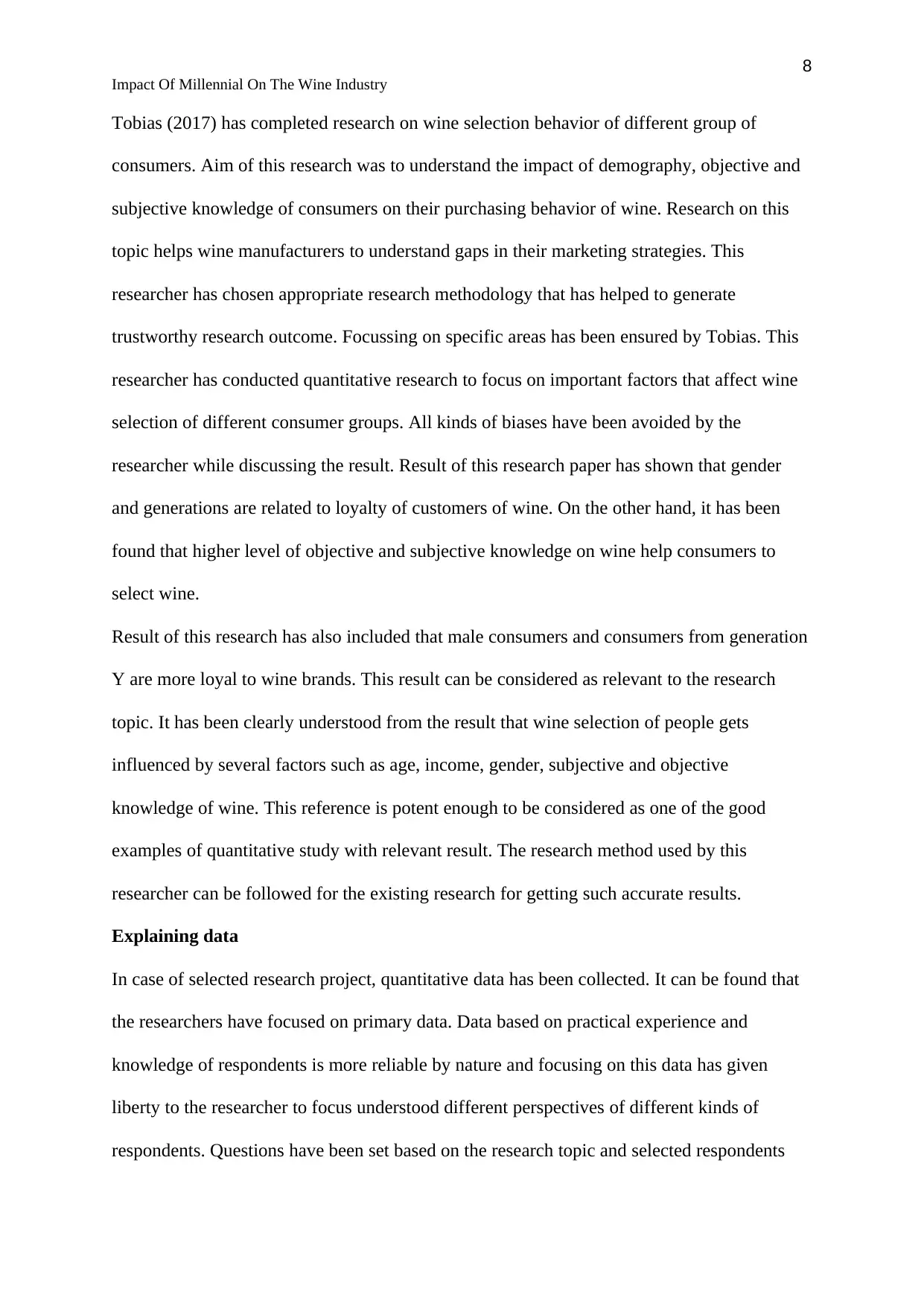
8
Impact Of Millennial On The Wine Industry
Tobias (2017) has completed research on wine selection behavior of different group of
consumers. Aim of this research was to understand the impact of demography, objective and
subjective knowledge of consumers on their purchasing behavior of wine. Research on this
topic helps wine manufacturers to understand gaps in their marketing strategies. This
researcher has chosen appropriate research methodology that has helped to generate
trustworthy research outcome. Focussing on specific areas has been ensured by Tobias. This
researcher has conducted quantitative research to focus on important factors that affect wine
selection of different consumer groups. All kinds of biases have been avoided by the
researcher while discussing the result. Result of this research paper has shown that gender
and generations are related to loyalty of customers of wine. On the other hand, it has been
found that higher level of objective and subjective knowledge on wine help consumers to
select wine.
Result of this research has also included that male consumers and consumers from generation
Y are more loyal to wine brands. This result can be considered as relevant to the research
topic. It has been clearly understood from the result that wine selection of people gets
influenced by several factors such as age, income, gender, subjective and objective
knowledge of wine. This reference is potent enough to be considered as one of the good
examples of quantitative study with relevant result. The research method used by this
researcher can be followed for the existing research for getting such accurate results.
Explaining data
In case of selected research project, quantitative data has been collected. It can be found that
the researchers have focused on primary data. Data based on practical experience and
knowledge of respondents is more reliable by nature and focusing on this data has given
liberty to the researcher to focus understood different perspectives of different kinds of
respondents. Questions have been set based on the research topic and selected respondents
Impact Of Millennial On The Wine Industry
Tobias (2017) has completed research on wine selection behavior of different group of
consumers. Aim of this research was to understand the impact of demography, objective and
subjective knowledge of consumers on their purchasing behavior of wine. Research on this
topic helps wine manufacturers to understand gaps in their marketing strategies. This
researcher has chosen appropriate research methodology that has helped to generate
trustworthy research outcome. Focussing on specific areas has been ensured by Tobias. This
researcher has conducted quantitative research to focus on important factors that affect wine
selection of different consumer groups. All kinds of biases have been avoided by the
researcher while discussing the result. Result of this research paper has shown that gender
and generations are related to loyalty of customers of wine. On the other hand, it has been
found that higher level of objective and subjective knowledge on wine help consumers to
select wine.
Result of this research has also included that male consumers and consumers from generation
Y are more loyal to wine brands. This result can be considered as relevant to the research
topic. It has been clearly understood from the result that wine selection of people gets
influenced by several factors such as age, income, gender, subjective and objective
knowledge of wine. This reference is potent enough to be considered as one of the good
examples of quantitative study with relevant result. The research method used by this
researcher can be followed for the existing research for getting such accurate results.
Explaining data
In case of selected research project, quantitative data has been collected. It can be found that
the researchers have focused on primary data. Data based on practical experience and
knowledge of respondents is more reliable by nature and focusing on this data has given
liberty to the researcher to focus understood different perspectives of different kinds of
respondents. Questions have been set based on the research topic and selected respondents
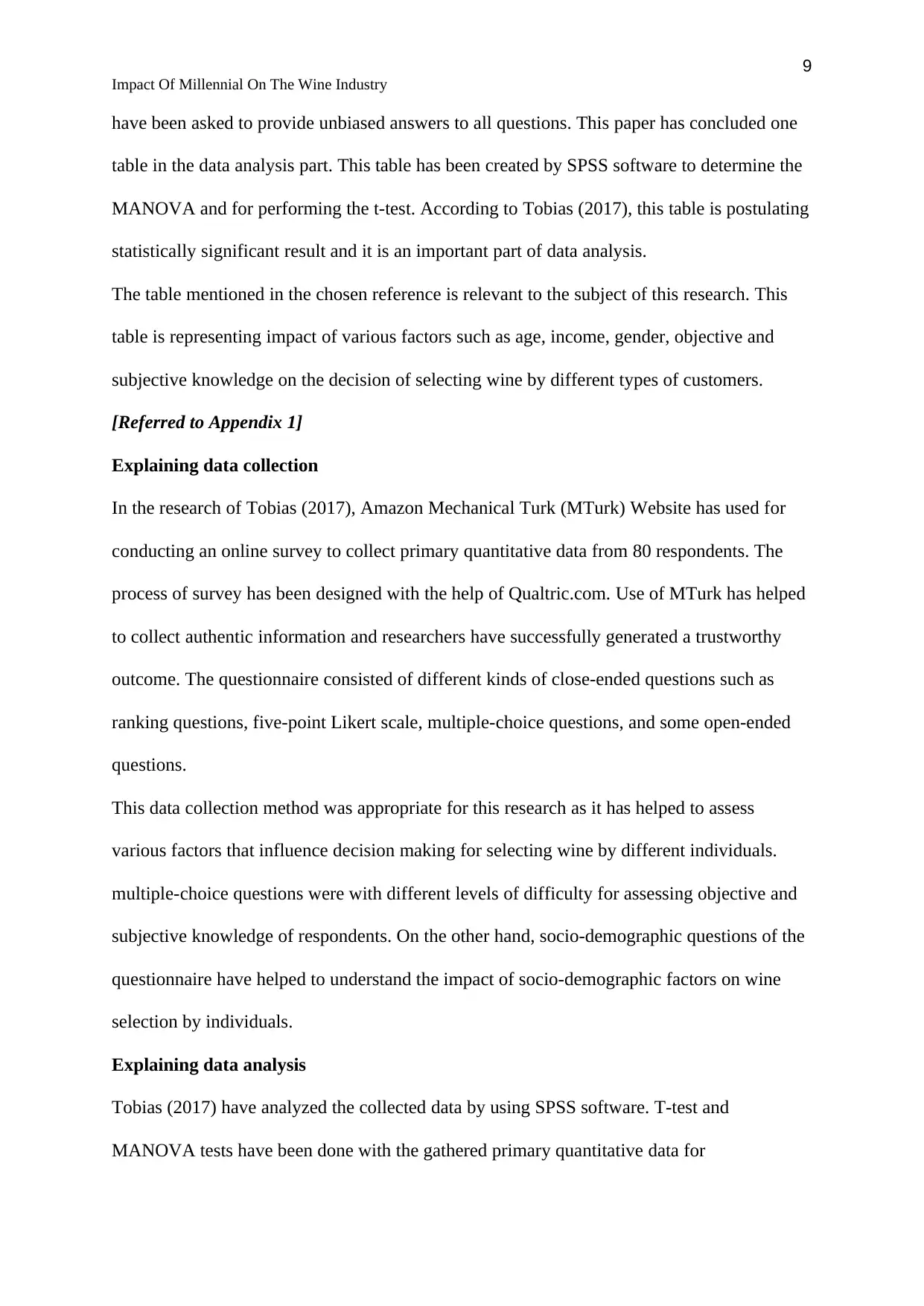
9
Impact Of Millennial On The Wine Industry
have been asked to provide unbiased answers to all questions. This paper has concluded one
table in the data analysis part. This table has been created by SPSS software to determine the
MANOVA and for performing the t-test. According to Tobias (2017), this table is postulating
statistically significant result and it is an important part of data analysis.
The table mentioned in the chosen reference is relevant to the subject of this research. This
table is representing impact of various factors such as age, income, gender, objective and
subjective knowledge on the decision of selecting wine by different types of customers.
[Referred to Appendix 1]
Explaining data collection
In the research of Tobias (2017), Amazon Mechanical Turk (MTurk) Website has used for
conducting an online survey to collect primary quantitative data from 80 respondents. The
process of survey has been designed with the help of Qualtric.com. Use of MTurk has helped
to collect authentic information and researchers have successfully generated a trustworthy
outcome. The questionnaire consisted of different kinds of close-ended questions such as
ranking questions, five-point Likert scale, multiple-choice questions, and some open-ended
questions.
This data collection method was appropriate for this research as it has helped to assess
various factors that influence decision making for selecting wine by different individuals.
multiple-choice questions were with different levels of difficulty for assessing objective and
subjective knowledge of respondents. On the other hand, socio-demographic questions of the
questionnaire have helped to understand the impact of socio-demographic factors on wine
selection by individuals.
Explaining data analysis
Tobias (2017) have analyzed the collected data by using SPSS software. T-test and
MANOVA tests have been done with the gathered primary quantitative data for
Impact Of Millennial On The Wine Industry
have been asked to provide unbiased answers to all questions. This paper has concluded one
table in the data analysis part. This table has been created by SPSS software to determine the
MANOVA and for performing the t-test. According to Tobias (2017), this table is postulating
statistically significant result and it is an important part of data analysis.
The table mentioned in the chosen reference is relevant to the subject of this research. This
table is representing impact of various factors such as age, income, gender, objective and
subjective knowledge on the decision of selecting wine by different types of customers.
[Referred to Appendix 1]
Explaining data collection
In the research of Tobias (2017), Amazon Mechanical Turk (MTurk) Website has used for
conducting an online survey to collect primary quantitative data from 80 respondents. The
process of survey has been designed with the help of Qualtric.com. Use of MTurk has helped
to collect authentic information and researchers have successfully generated a trustworthy
outcome. The questionnaire consisted of different kinds of close-ended questions such as
ranking questions, five-point Likert scale, multiple-choice questions, and some open-ended
questions.
This data collection method was appropriate for this research as it has helped to assess
various factors that influence decision making for selecting wine by different individuals.
multiple-choice questions were with different levels of difficulty for assessing objective and
subjective knowledge of respondents. On the other hand, socio-demographic questions of the
questionnaire have helped to understand the impact of socio-demographic factors on wine
selection by individuals.
Explaining data analysis
Tobias (2017) have analyzed the collected data by using SPSS software. T-test and
MANOVA tests have been done with the gathered primary quantitative data for
⊘ This is a preview!⊘
Do you want full access?
Subscribe today to unlock all pages.

Trusted by 1+ million students worldwide
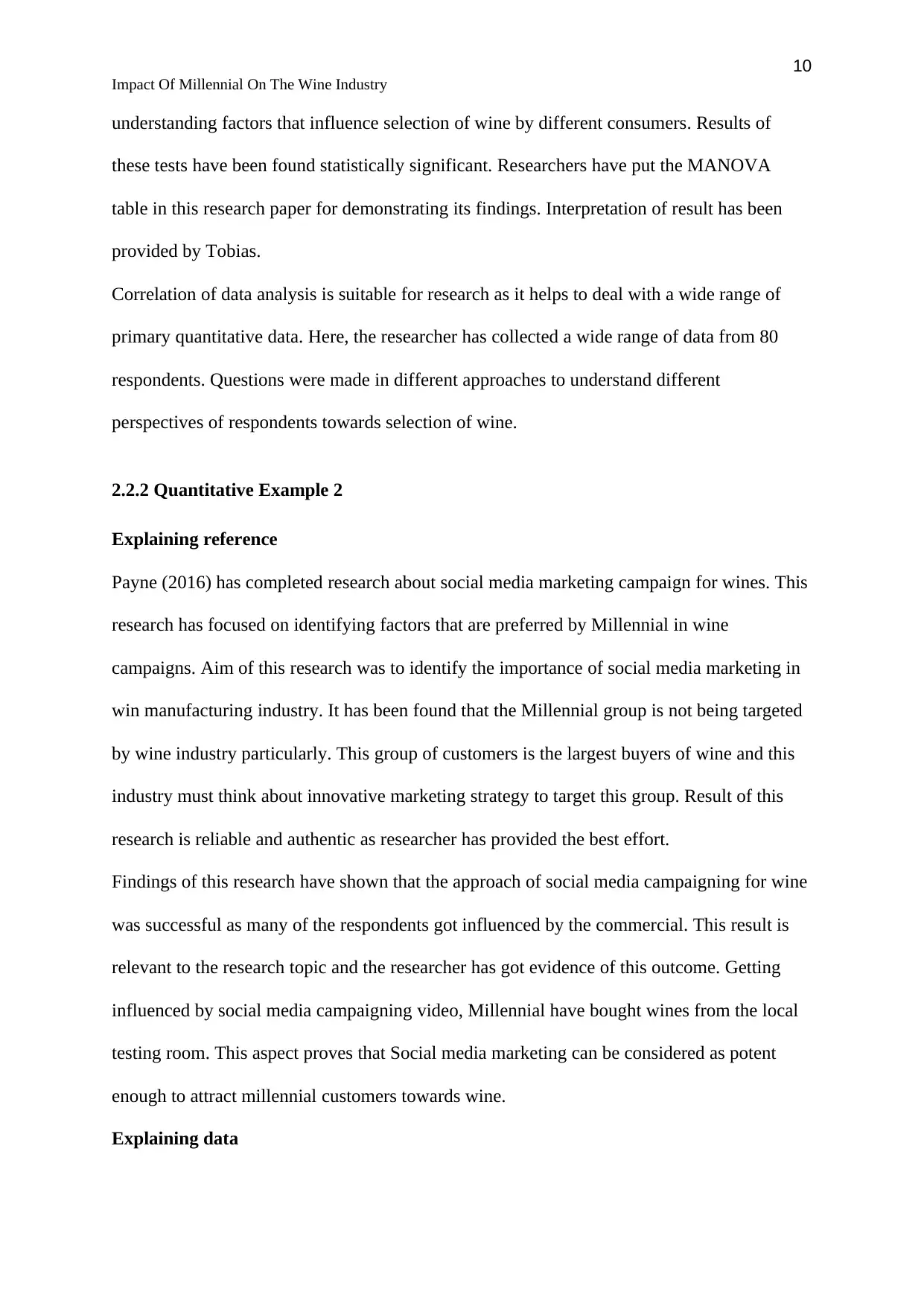
10
Impact Of Millennial On The Wine Industry
understanding factors that influence selection of wine by different consumers. Results of
these tests have been found statistically significant. Researchers have put the MANOVA
table in this research paper for demonstrating its findings. Interpretation of result has been
provided by Tobias.
Correlation of data analysis is suitable for research as it helps to deal with a wide range of
primary quantitative data. Here, the researcher has collected a wide range of data from 80
respondents. Questions were made in different approaches to understand different
perspectives of respondents towards selection of wine.
2.2.2 Quantitative Example 2
Explaining reference
Payne (2016) has completed research about social media marketing campaign for wines. This
research has focused on identifying factors that are preferred by Millennial in wine
campaigns. Aim of this research was to identify the importance of social media marketing in
win manufacturing industry. It has been found that the Millennial group is not being targeted
by wine industry particularly. This group of customers is the largest buyers of wine and this
industry must think about innovative marketing strategy to target this group. Result of this
research is reliable and authentic as researcher has provided the best effort.
Findings of this research have shown that the approach of social media campaigning for wine
was successful as many of the respondents got influenced by the commercial. This result is
relevant to the research topic and the researcher has got evidence of this outcome. Getting
influenced by social media campaigning video, Millennial have bought wines from the local
testing room. This aspect proves that Social media marketing can be considered as potent
enough to attract millennial customers towards wine.
Explaining data
Impact Of Millennial On The Wine Industry
understanding factors that influence selection of wine by different consumers. Results of
these tests have been found statistically significant. Researchers have put the MANOVA
table in this research paper for demonstrating its findings. Interpretation of result has been
provided by Tobias.
Correlation of data analysis is suitable for research as it helps to deal with a wide range of
primary quantitative data. Here, the researcher has collected a wide range of data from 80
respondents. Questions were made in different approaches to understand different
perspectives of respondents towards selection of wine.
2.2.2 Quantitative Example 2
Explaining reference
Payne (2016) has completed research about social media marketing campaign for wines. This
research has focused on identifying factors that are preferred by Millennial in wine
campaigns. Aim of this research was to identify the importance of social media marketing in
win manufacturing industry. It has been found that the Millennial group is not being targeted
by wine industry particularly. This group of customers is the largest buyers of wine and this
industry must think about innovative marketing strategy to target this group. Result of this
research is reliable and authentic as researcher has provided the best effort.
Findings of this research have shown that the approach of social media campaigning for wine
was successful as many of the respondents got influenced by the commercial. This result is
relevant to the research topic and the researcher has got evidence of this outcome. Getting
influenced by social media campaigning video, Millennial have bought wines from the local
testing room. This aspect proves that Social media marketing can be considered as potent
enough to attract millennial customers towards wine.
Explaining data
Paraphrase This Document
Need a fresh take? Get an instant paraphrase of this document with our AI Paraphraser
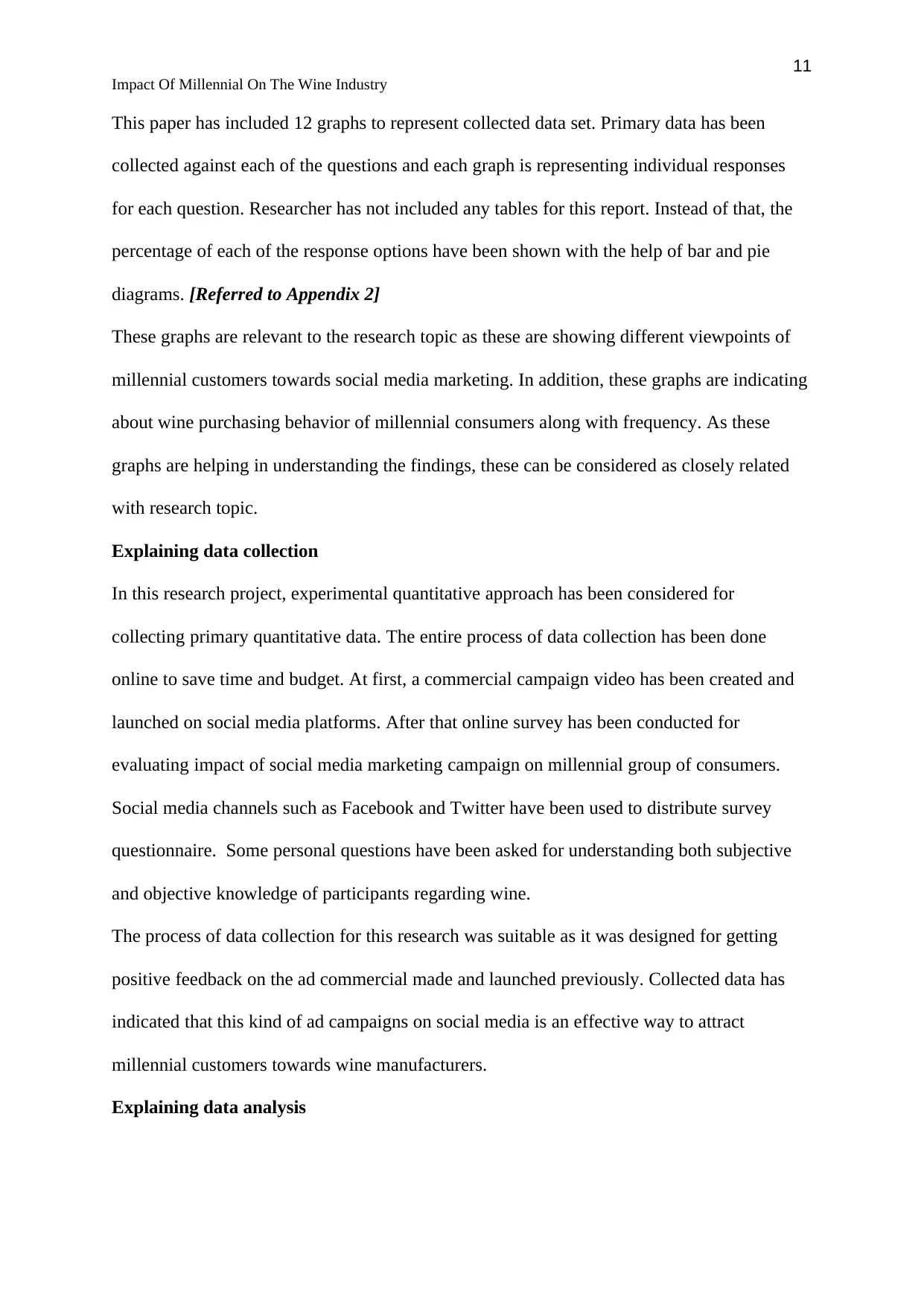
11
Impact Of Millennial On The Wine Industry
This paper has included 12 graphs to represent collected data set. Primary data has been
collected against each of the questions and each graph is representing individual responses
for each question. Researcher has not included any tables for this report. Instead of that, the
percentage of each of the response options have been shown with the help of bar and pie
diagrams. [Referred to Appendix 2]
These graphs are relevant to the research topic as these are showing different viewpoints of
millennial customers towards social media marketing. In addition, these graphs are indicating
about wine purchasing behavior of millennial consumers along with frequency. As these
graphs are helping in understanding the findings, these can be considered as closely related
with research topic.
Explaining data collection
In this research project, experimental quantitative approach has been considered for
collecting primary quantitative data. The entire process of data collection has been done
online to save time and budget. At first, a commercial campaign video has been created and
launched on social media platforms. After that online survey has been conducted for
evaluating impact of social media marketing campaign on millennial group of consumers.
Social media channels such as Facebook and Twitter have been used to distribute survey
questionnaire. Some personal questions have been asked for understanding both subjective
and objective knowledge of participants regarding wine.
The process of data collection for this research was suitable as it was designed for getting
positive feedback on the ad commercial made and launched previously. Collected data has
indicated that this kind of ad campaigns on social media is an effective way to attract
millennial customers towards wine manufacturers.
Explaining data analysis
Impact Of Millennial On The Wine Industry
This paper has included 12 graphs to represent collected data set. Primary data has been
collected against each of the questions and each graph is representing individual responses
for each question. Researcher has not included any tables for this report. Instead of that, the
percentage of each of the response options have been shown with the help of bar and pie
diagrams. [Referred to Appendix 2]
These graphs are relevant to the research topic as these are showing different viewpoints of
millennial customers towards social media marketing. In addition, these graphs are indicating
about wine purchasing behavior of millennial consumers along with frequency. As these
graphs are helping in understanding the findings, these can be considered as closely related
with research topic.
Explaining data collection
In this research project, experimental quantitative approach has been considered for
collecting primary quantitative data. The entire process of data collection has been done
online to save time and budget. At first, a commercial campaign video has been created and
launched on social media platforms. After that online survey has been conducted for
evaluating impact of social media marketing campaign on millennial group of consumers.
Social media channels such as Facebook and Twitter have been used to distribute survey
questionnaire. Some personal questions have been asked for understanding both subjective
and objective knowledge of participants regarding wine.
The process of data collection for this research was suitable as it was designed for getting
positive feedback on the ad commercial made and launched previously. Collected data has
indicated that this kind of ad campaigns on social media is an effective way to attract
millennial customers towards wine manufacturers.
Explaining data analysis
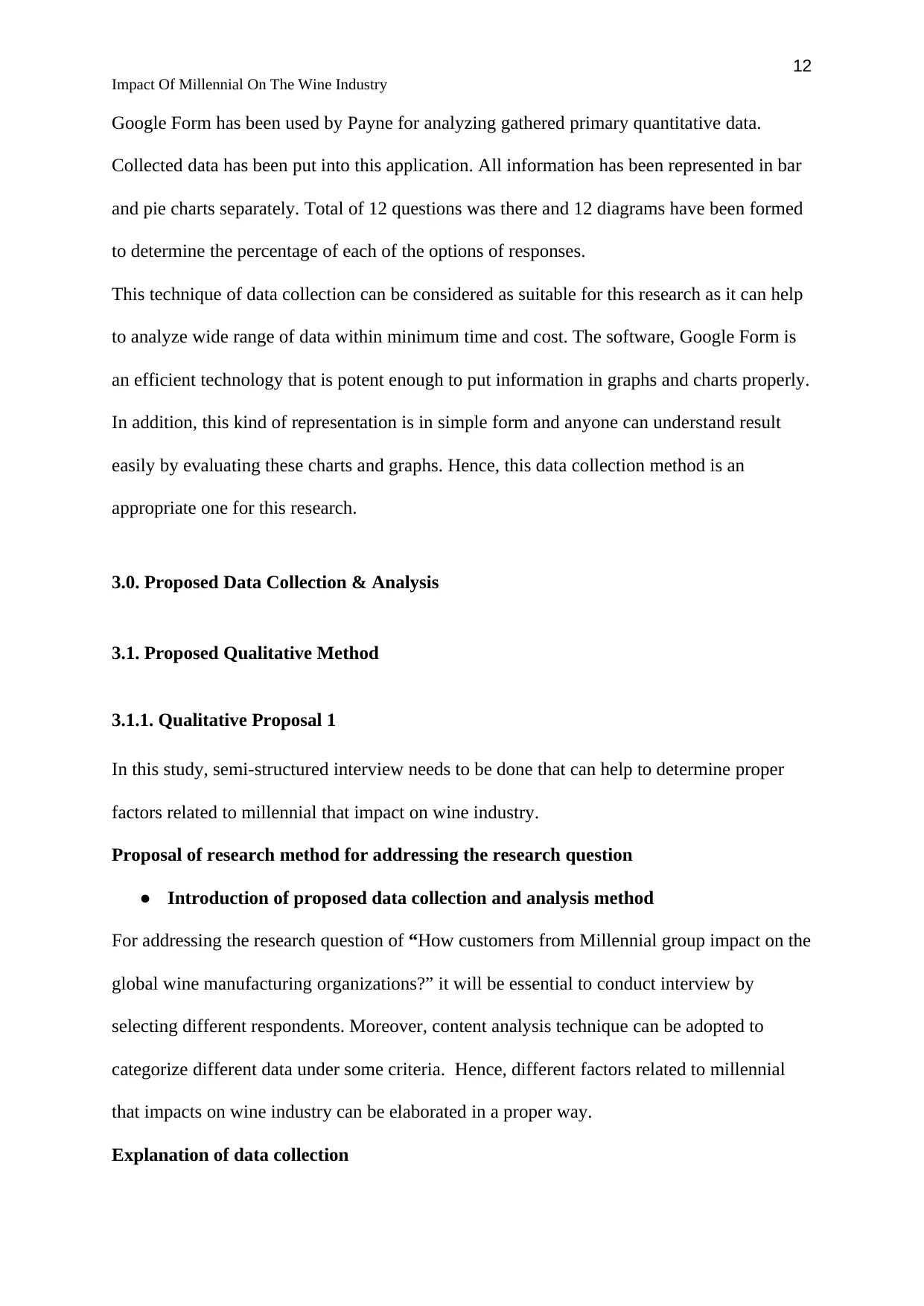
12
Impact Of Millennial On The Wine Industry
Google Form has been used by Payne for analyzing gathered primary quantitative data.
Collected data has been put into this application. All information has been represented in bar
and pie charts separately. Total of 12 questions was there and 12 diagrams have been formed
to determine the percentage of each of the options of responses.
This technique of data collection can be considered as suitable for this research as it can help
to analyze wide range of data within minimum time and cost. The software, Google Form is
an efficient technology that is potent enough to put information in graphs and charts properly.
In addition, this kind of representation is in simple form and anyone can understand result
easily by evaluating these charts and graphs. Hence, this data collection method is an
appropriate one for this research.
3.0. Proposed Data Collection & Analysis
3.1. Proposed Qualitative Method
3.1.1. Qualitative Proposal 1
In this study, semi-structured interview needs to be done that can help to determine proper
factors related to millennial that impact on wine industry.
Proposal of research method for addressing the research question
● Introduction of proposed data collection and analysis method
For addressing the research question of “How customers from Millennial group impact on the
global wine manufacturing organizations?” it will be essential to conduct interview by
selecting different respondents. Moreover, content analysis technique can be adopted to
categorize different data under some criteria. Hence, different factors related to millennial
that impacts on wine industry can be elaborated in a proper way.
Explanation of data collection
Impact Of Millennial On The Wine Industry
Google Form has been used by Payne for analyzing gathered primary quantitative data.
Collected data has been put into this application. All information has been represented in bar
and pie charts separately. Total of 12 questions was there and 12 diagrams have been formed
to determine the percentage of each of the options of responses.
This technique of data collection can be considered as suitable for this research as it can help
to analyze wide range of data within minimum time and cost. The software, Google Form is
an efficient technology that is potent enough to put information in graphs and charts properly.
In addition, this kind of representation is in simple form and anyone can understand result
easily by evaluating these charts and graphs. Hence, this data collection method is an
appropriate one for this research.
3.0. Proposed Data Collection & Analysis
3.1. Proposed Qualitative Method
3.1.1. Qualitative Proposal 1
In this study, semi-structured interview needs to be done that can help to determine proper
factors related to millennial that impact on wine industry.
Proposal of research method for addressing the research question
● Introduction of proposed data collection and analysis method
For addressing the research question of “How customers from Millennial group impact on the
global wine manufacturing organizations?” it will be essential to conduct interview by
selecting different respondents. Moreover, content analysis technique can be adopted to
categorize different data under some criteria. Hence, different factors related to millennial
that impacts on wine industry can be elaborated in a proper way.
Explanation of data collection
⊘ This is a preview!⊘
Do you want full access?
Subscribe today to unlock all pages.

Trusted by 1+ million students worldwide
1 out of 27
Related Documents
Your All-in-One AI-Powered Toolkit for Academic Success.
+13062052269
info@desklib.com
Available 24*7 on WhatsApp / Email
![[object Object]](/_next/static/media/star-bottom.7253800d.svg)
Unlock your academic potential
Copyright © 2020–2025 A2Z Services. All Rights Reserved. Developed and managed by ZUCOL.



